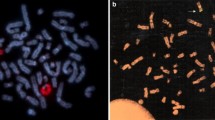Summary
The X-linked testicular feminization mutation (Tfm) in the mouse is characterized by an androgen receptor defect. Due to random X-chromosome inactivation, XTfm/X+ heterozygotes are mosaics with respect to Tfm. They are composed of androgen receptor deficient XTfm cells and normal X+ wild-type cells. If Tfm heterozygotes are converted to XX males by the sex reversal factor (Sxr) the mosaicism is expressed. Therefore in sex reversed Tfm heterozygotes (XTfm/X+-Sxr) intersexual sex organs develop. In five intersexes with small male accessory glands and hypospadia and one heavily feminized intersex with vagina and caudally dislocated deferent ducts the mosaic is visualized by 3H-DHT-autoradiography. In the epididymis differentiated wild-type cells show nuclear labeling, whereas undifferentiated Tfm cells are unlabeled. Unlabeled Tfm cells are also encountered in the vesicular glands of the heavily feminized animal, demonstrating that Tfm cells can participate in the formation of male sex glands. The urethral glands of the mosaic animals are composed of unlabeled Tfm lobules exhibiting the female phenotype of the glands, and of labeled wild-type lobules exhibiting the male phenotype. Formation of a vagina and deviation of the deferent ducts is correlated with lack of androgen binding sites in the connective tissue.
Similar content being viewed by others
References
Attardi B, Ohno S (1974) Cytosol androgen receptor from kidney of normal and testicular feminized (Tfm) mice. Cell 2:205–212
Bok G, Drews U (1983) The role of the Wolffian ducts in the formation of the sinus vagina: an organ culture study. J Embryol Exp Morphol 73:175–195
Bouton MM, Pomin C, Grandadam JA (1981) Estrogen regulation of rat prostate androgen receptor. J Steroid Biochem 15:403–408
Cattanach BM, Pollard CE, Hawkes SG (1971) Sex reversed mice: XX and XO males. Cytogenetics 10:319–337
Drews U (1975) Direct and mediated effects of testosterone: The development of intersexes in sex reversed mosaic mice, heterozygous for testicular feminization. Anat Embryol 146:325–340
Drews U (1981) Geschlechtsbestimmung und Geschlechtsdifferenzierung. Naturwissenschaften 68:177–182
Drews U, Drews U (1975) Metabolic cooperation between Tfm and wild-type cells in mosaic mice after induction of DNA synthesis. Cell 6:475–479
Drews U, Drews U (1977) Regression of mouse mammary gland anlagen in recombinations of Tfm and wild-type tissues: Testosterone acts via the mesenchyme. Cell 10:401–404
Drews U, Alonso-Lozano V (1974) X-inactivation pattern in the epididymis of sex reversed mice heterozygous for testicular feminization. J Embryol Exp Morphol 32:217–225
Drews U, Dieterich HJ (1978) Cell death in the mosaic epididymis of sex reversed mice, heterozygous for testicular feminization. Anat Embryol 152:193–203
Gehring U, Tomkins GM (1974) Characterization of a hormone receptor defect in the androgen-insensitivity mutant. Cell 3:59–64
Hannappel E, Drews U (1981) Stimulation of growth by testosterone via the mesenchyme. Recombination of tissues from Tfm and wild-type preputial gland anlagen of mouse embryo. Cell Tissue Res 221:321–332
Heuberger B, Fitzka I, Wasner G, Kratochwil K (1982) Induction of androgen receptor formation by epithelial-mesenchymal interaction in embryonic mouse mammary gland. Proc Natl Acad Sci USA 79-2957
Jost A (1972) A new look at the mechanisms controlling sex differentiation in mammals. John Hopkins Med J 130:38–53
Kratochwil K, Schwartz P (1976) Tissue interaction in androgen response of embryonic mammary rudiment of mouse: identification of target for testosterone. Proc Natl Acad Sci USA 73:4041–4044
Lasnitzki I, Mizuno T (1980) Prostatic induction: Interaction of epithelium and mesenchyme from normal wild-type mice and androgen-insensitive mice with testicular feminization. Endocrinol 85:423–428
Lyon MF, Hawkes SG (1970) X-linked gene for testicular feminization in the mouse. Nature 227:1217–1219
Mauch RB, Thiedemann K-U, Drews U (1985) The vagina is formed by downgrowth of Wolffian and Müllerian ducts. Graphical reconstructions from normal and Tfm mouse embryos. Anat Embryol 172:75–87
McLaren A (1983) Sex reversal in mouse. Differentiation 23 [Suppl]:93–98
Neumann F, Elger W, Steinbeck H, Gräß KJ (1975) The role of androgens in sexual differentiation of mammals. In: Reinboth R (ed) Intersexuality in the animal kingdom. Springer, Berlin Heidelberg New York, pp 407–421
Ohno S, Geller LN, Young Lai EV (1974) Tfm mutation and masculinization versus feminization of the mouse central nervous system. Cell 3:235–242
Raynaud A (1950) Recherches expérimentales sur le développement de l'appareil génital ét le fonctionnement des glandes endocrines des foetus de souris et de mulot. Arch Microsc Morphol 39:519–576
Schleicher G, Drews U, Stumpf WE, Sar M (1984) Differential distribution of dihydrotestosterone and estradiol binding sites in the epididymis of the mouse. Histochemistry 81:139–147
Schleicher G, Stumpf WE, Drews U, Thiedemann KU, Sar M (1985) Differential distribution of 3H dihydrotestosterone and 3H estradiol nuclear binding sites in mouse male accessory sex organs. An autoradiographic study. Histochemistry 82:453–461
Shannon JM, Cunha GR (1983) Autoradiographic localization of androgen binding in the developing mouse prostate. The Prostate 4:367–373
Stumpf WE, Sar M (1975) Autoradiographic techniques for localizing steroid hormones: In: O'Malley BW, Hardman JG (eds) Methods of enzymology, vol 36. Academic Press, New York, pp 135–156
Sugimura Y, Norman JT, Cunha GR, Shannon JM (1985) Regional differences in the inductive activity of the mesenchyme of the embryonic mouse urogenital sinus. Prostate 7:253–260
Takeda H, Mizuno T, Lasnitzki I (1985) Autoradiographic studies of androgen-binding sites in the rat urogenital sinus and postnatal prostate. J Endocrinol 104:87–92
Takeda H, Suzuki M, Lasnitzki I, Mizuno T (1987a) Visualization of X-chromosome inactivation mosaicism of Tfm gene in XTfm/X+ heterozygous female mice. J Endocrinol 114:125–129
Takeda H, Lasnitzki I, Mizuno T (1987b) Change of mosaic pattern by androgens during prostatic bud formation in XTfm/X+ heterozygous female mice. J Endocrinol 114:131–137
Thiedemann K-U, Vanittanakom P, Schweers F-M, Drews U (1986) Embryonic cholinesterase activity during morphogenesis of the mouse genital tract. Cell Tissue Res 244:153–164
Author information
Authors and Affiliations
Rights and permissions
About this article
Cite this article
Schleicher, G., Stumpf, W.E., Thiedemann, KU. et al. Intersex mice composed of androgen insensitive Tfm and wild-type cells analysed by 3H dihydrotestosterone autoradiography. Anat Embryol 178, 521–528 (1988). https://doi.org/10.1007/BF00305039
Accepted:
Issue Date:
DOI: https://doi.org/10.1007/BF00305039




